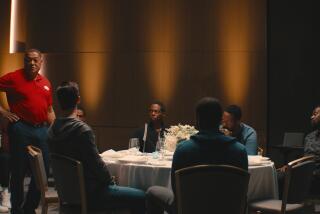The Only Color That Matters in This Dispute Is Clearly Green
- Share via
Now the crowning indignity: the race card.
Just when you thought things between the NBA and its players couldn’t get worse, here’s the latest demonstration of that ‘90s phenomenon, wherein issues involving people of different races turn racial, after which it’s hard to remember what they were about in the first place.
In keeping with these negotiations, both sides say they weren’t the ones who introduced it.
“I don’t think race is [the problem],” union head Billy Hunter said Wednesday. “I think the problem is you’ve got a group of extremely successful businessmen who own these teams, most of whom are billionaires. You’ve got men who are accustomed to seeing those dictates honored, so when they make a demand, it’s customary that most people respond to it. . . .
“On the other side of the table, you’ve got a group of players who are predominantly African-American in origin, so I think people can read into it anything they want.
“Subliminally, it may be there, but I think it’s all about dollars, it’s all about hard economics. . . .”
Whether racial issues are there subliminally, or represent the grumbling of locked-out players amplified by a bored press, depends, indeed, on what one wants to read into it.
While racism may still exist in American society to a degree many whites can’t imagine, this remains a dispute between wealthy owners and the world’s richest players--you know the NBA rules when the Dodgers’ Kevin Brown calls his $105-million contract “basketball money”--about the distribution of $2 billion worth of proceeds.
Exactly where are we supposed to draw the color lines in this thing?
The NBA officials and owners are predominantly white.
The rich players are predominantly black but are represented by rich agents who are predominantly white.
The poor players, a relative term, since $250,000 a year makes you an NBA pauper, are predominantly black.
If Commissioner David Stern is, indeed, driving the union to the wall--or overplaying his hand, insisting on a poverty that doesn’t seem supported by anecdotal evidence, such as small-market owners paying coaches $5 million a season--he has had basic arithmetic on his side all along:
The players contracted for 50% of revenues, gave owners a re-opener at 52% and were up to 57% when Stern decided to exercise his option.
The players had no reason to complain, though, of course, they did. It’s what they do, about roles, salaries, awards and the all-encompassing respect, which has become such a touchstone, we have had to invent words for its absence, like “dissing.” This isn’t a function of race, but rather a cross-cultural sense of hyper-entitlement, because most athletes have been fawned over and recruited since they emerged from puberty.
The notion that NBA ownership would be happier to give 57% to a predominantly white union is laughable. The crux of the problem remains the high-end players, whose skyrocketing pay looted not only teams and owners but their own union’s fast-diminishing middle class.
Of course, players are encouraged not to point fingers at each other, but at the outside enemy.
Insiders have seen racial issues bubbling beneath the surface for months. Thankfully, they stayed there until last week, when several black players held a news conference to promote an Atlantic City exhibition that (white) agents David Falk and Arn Tellem had put together.
With its $1,000 courtside seats and its announcement that 10% of the proceeds would go to UNICEF and 90% to the NBA’s $250,000-a-year needy, this took a lot of promoting, which the players undertook gamely, if not successfully.
“They make a lot of money,” union president Patrick Ewing said of needy players, “but they also spend a lot of money.”
The promoters quickly decided to give everything to UNICEF. Nevertheless, the New York Times’ William C. Rhoden wrote a column calling the exhibition “ill-conceived” but noting “a deep-seated paternalism that often places the news media closer to management than to players,” adding:
“It’s all right for players to make money for owners, to keep the plantation lighted and warm.”
Meanwhile, NBA players were holding exhibitions in Houston, Dallas, Miami and Pauley Pavilion, without trying to devise a formula for dividing proceeds between starving children and unemployed NBA players, eliciting little interest but little in the way of criticism, either.
This week, Newsweek ran a story on racial aspects of the lockout, quoting Alonzo Mourning as saying: “Owners think we’re blacks who should be happy with what we got. I’m not saying it’s all about race, but it plays a factor.”
Wednesday, the New York Times ran a story on its front page, right under the ones about the possible impeachment of President Clinton, with the headline: “Both Sides in N.B.A. Lockout Say Race Complicates Talks.”
“Both sides” turned out to mean Mourning’s Newsweek quote plus comments by Hunter, Dikembe Mutombo and Jayson Williams, who all said they didn’t think it was racial but knew players who did. The management side was represented by an unidentified official who said:
“We don’t deny the possibility that the union has the ability to use race as a rallying point. There may be code words used to rally its members, code words that have racial connotations.”
OK, at this point, we should all be able to join hands and conclude that things have gotten far enough out of hand.
Having done more harm to the NBA fabric than they may be able to repair in the term of this woebegone deal that they’ve been unable to make, let’s hope our heroes of all races get this over soon. If things get any worse, there may be fighting in the streets next.
More to Read
All things Lakers, all the time.
Get all the Lakers news you need in Dan Woike's weekly newsletter.
You may occasionally receive promotional content from the Los Angeles Times.






